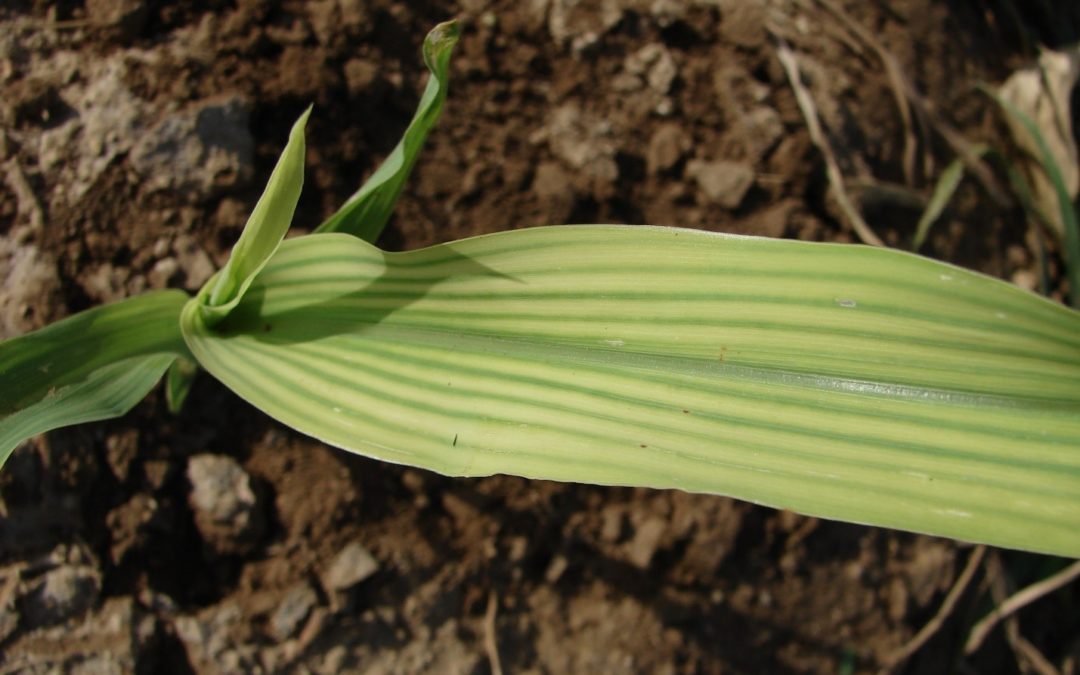Highlights:
- Iron in agricultural soils has many direct and indirect effects on crop production.
- The availability of iron in soil and the efficacy of iron applied to crops can be framed by 4R Nutrient Stewardship principles.
- Management strategies to alleviate iron deficiency symptoms exist in crop- and region-specific forms.
In most agricultural soils iron occurs in large quantities and total iron concentrations can be 50,000 times the crop’s annual demand; however, soil and environmental factors often inhibit iron availability to growing crops. Iron is essential for many plant metabolic activities. In fact, iron is so important to photosynthesis that the stark iron deficiency symptom is light green color (chlorosis) in young vegetative growth.
Measurable soil properties like soil pH, carbonate concentration, aeration, and organic matter content can be used to determine iron deficiencies. In general, as soil pH values approach 7.5, iron is in its least soluble form, explaining the frequency of iron deficiency chlorosis (IDC) in regions with calcareous parent material (e.g. limestone) and higher soil pH ranges.
In a 2016 research report the North Central Soybean Research Program found 13 percent of fields surveyed as having IDC present, and some crop reporting districts incurred greater than 40 percent of fields with IDC. Additionally, soil wetness status greatly affects the solubility of iron. Saturated conditions reduce iron into a form that is mobile in the soil with water. This also affects nutrients like phosphorus. In neutral to acidic soils, iron and phosphorus bond and reduce the availability of both to growing crops. This means that saturated soils can not only make iron and phosphorus soluble, but also that phosphorus can be lost from farm fields after long periods of saturation or is located in depressions (areas where water accumulates). Sub-field scale losses of phosphorus to tile drainage are well-documented. Funded by the 4R Research Fund, Nutri-Net co-investigator Lowell Gentry, with the University of Illinois, recently published evidence of this phenomena. Gentry and others showed that strong relationships between depressional depths and dissolved phosphorus losses.
Using a 4R approach by considering the source, rate, timing, and placement of iron fertilization can compensate for iron deficiency. One part of an approach is to consider crop variety and tolerance to low iron availability. The second part is considering soil- or foliar-applied fertilizer applications to avoid or correct deficiency, or growers can work to attain soil conditions that foster greater crop availability of iron. With such dynamic soil properties influencing iron availability, optimizing iron nutrition is difficult and, in most cases, using practices that inform the 4Rs, such as soil tests, plant analysis, and yield maps, when putting a plan together pays dividends. An ongoing research project led by Utah State University professor Matt Yost is tracking the uptake of nutrients, like iron, in alfalfa, corn silage, and wheat to understand how 4R-driven practices affect crop yield and quality.
Through iron deficiency symptoms can be visually apparent in most crops, underlying reasoning for reduced uptake or availability can be more complex. Dedicating time to understanding the soil-plant environment in each distinctive soil where you suspect iron to be limiting productivity is well-worth it.
Image: iron deficiency in sorghum

